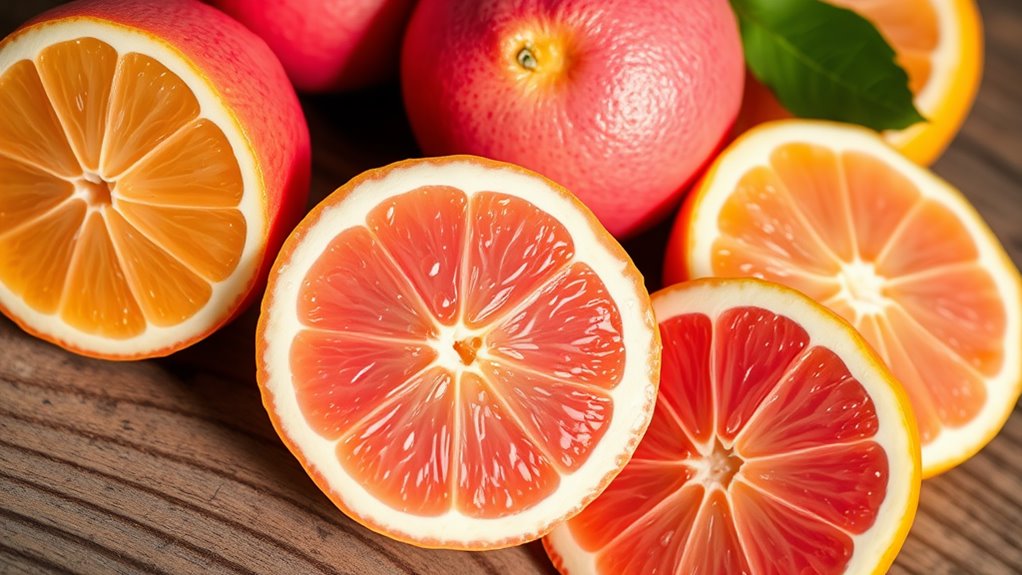
Pink lemons are a natural mutation of the Eureka lemon, characterized by their green and white striped rind and light pink flesh. They have a unique flavor profile that combines sweetness and tanginess, often with lower acidity compared to regular lemons. Their semi-rough texture and striking appearance make them visually appealing. Cultivated primarily in warm climates, they are less productive but gaining popularity. Discover how their nutritional benefits and culinary versatility set them apart further.
Although you might be familiar with the classic yellow lemon, pink lemons present a fascinating twist on this citrus staple. Discovered in Southern California around 1930, these unique fruits are a natural mutation of the Eureka lemon tree. Classified as *Citrus limon* and belonging to the Rutaceae family, pink lemons are also referred to as Variegated Pink lemons, Pink Lemonade lemons, or Zebra lemons.
The evergreen trees typically reach heights of up to four meters and feature highly fragrant variegated leaves that alternate between green and white.
When examining the physical characteristics of pink lemons, you'll notice their small to medium size and oblong to oval shape. The rind possesses a semi-rough texture adorned with green and white stripes, which fade as the fruit ripens. The flesh reveals a light pink or rosy hue due to the presence of lycopene, a natural pigment. Remarkably, these lemons are often seedless or contain very few seeds. Despite the flesh's color, the juice itself remains clear, distinguishing it from other varieties.
In terms of flavor, pink lemons offer a delightful combination of sweetness and tanginess, accented by subtle tart, floral, and fruity notes. Their acidity is lower than that of standard lemons, making them a versatile ingredient in various culinary applications. You'll find that their bright citrus scent enhances the appeal of any dish, and they pair splendidly with herbs like lavender and rosemary. Their low acidity makes them ideal for those who prefer a milder lemon flavor.
Whether used in desserts, beverages, or savory dishes, pink lemons deliver a unique flavor profile that elevates the overall dining experience.
From a nutritional standpoint, pink lemons are a powerhouse of health benefits. They provide significant amounts of vitamin C, which plays a significant role in supporting immunity and collagen production. Additionally, their fiber content aids in digestive health, while calcium contributes to bone and tooth health. The antioxidants derived from lycopene further enhance their nutritional value, making pink lemons a beneficial addition to your diet.
In terms of cultivation, pink lemons thrive in warm climates, particularly in regions like Southern California. However, they're less productive than their common Eureka counterparts. Harvesting occurs during summer, late fall, and early spring, and many growers cultivate them for ornamental purposes due to their striking variegated leaves.
Although they're gaining popularity due to social media exposure, their production limitations keep them classified as a specialty citrus.
You might find pink lemons primarily in Southern California specialty markets and stores, with online purchasing options available as well. Their seasonal availability ranges from winter to mid-summer, and demand for these unique fruits continues to rise due to their appealing appearance and versatile culinary uses.
Incorporating them into salads, seafood dishes, sauces, and baked goods can enhance your cooking repertoire, while their flavor adds excitement to lemonades, cocktails, and sparkling drinks. With their distinct characteristics, pink lemons offer a remarkable alternative to the traditional yellow lemon.
Conclusion
To sum up, pink lemons offer a unique twist on the familiar citrus experience, with their striking color and subtly sweeter flavor profile. While some may question their practicality in everyday cooking, consider using their vibrant hue to elevate dishes and drinks, making them visually appealing and delicious. Their distinct taste can enhance recipes, transforming ordinary meals into extraordinary culinary creations. Embracing pink lemons not only diversifies your palate but also adds a splash of creativity to your kitchen.



